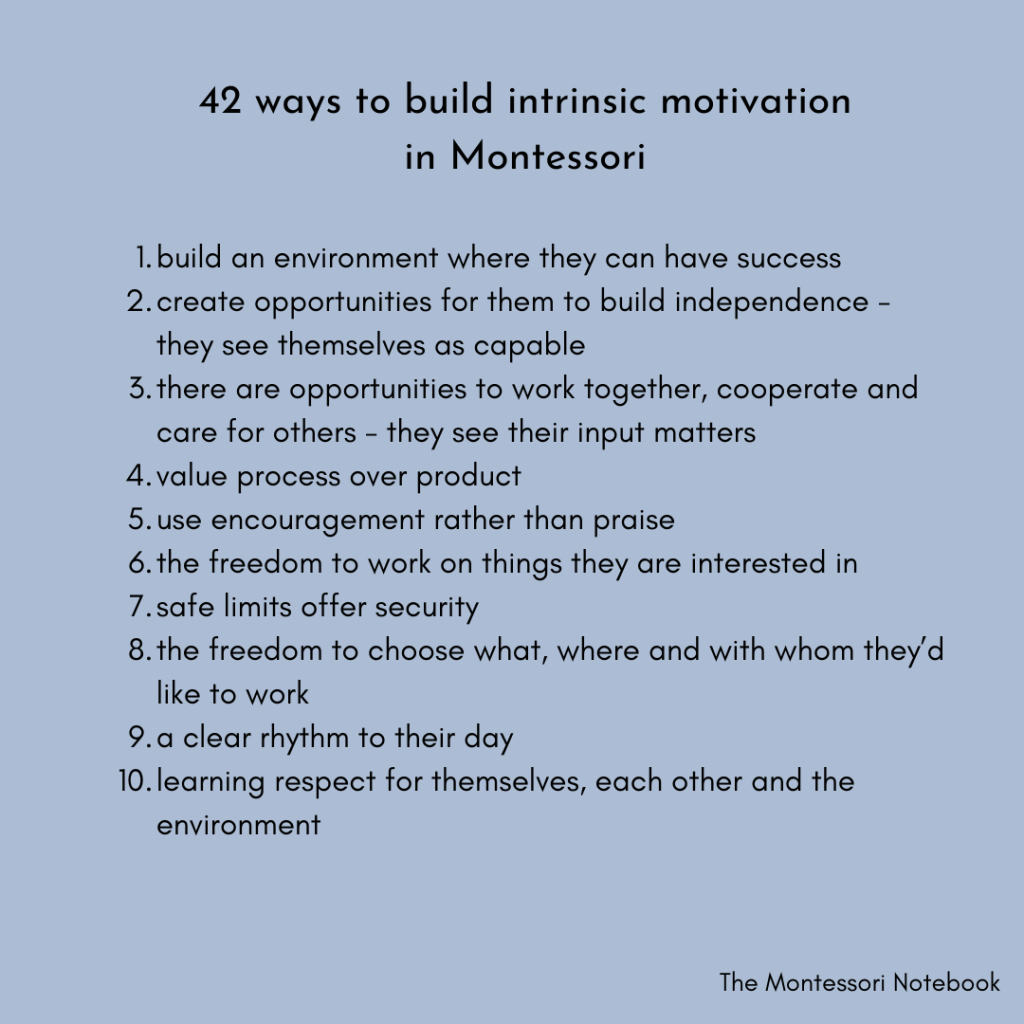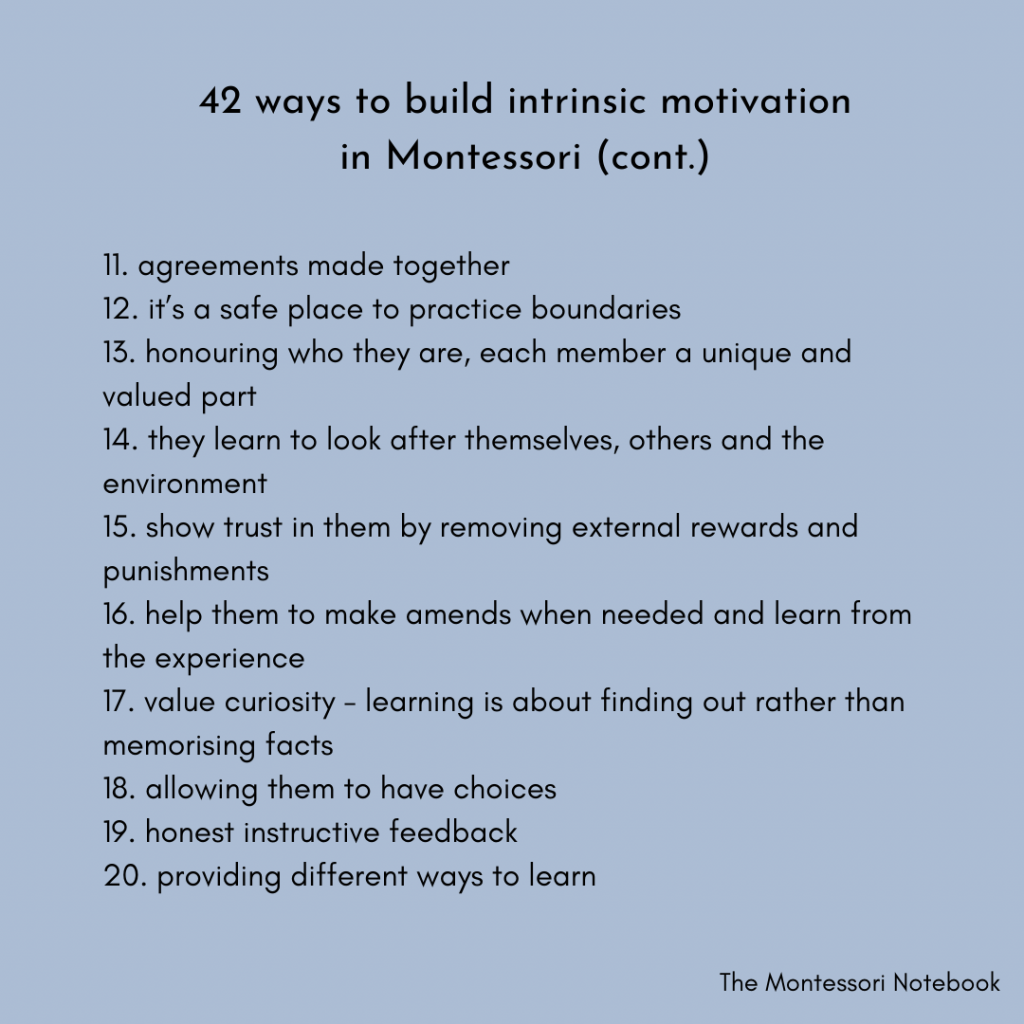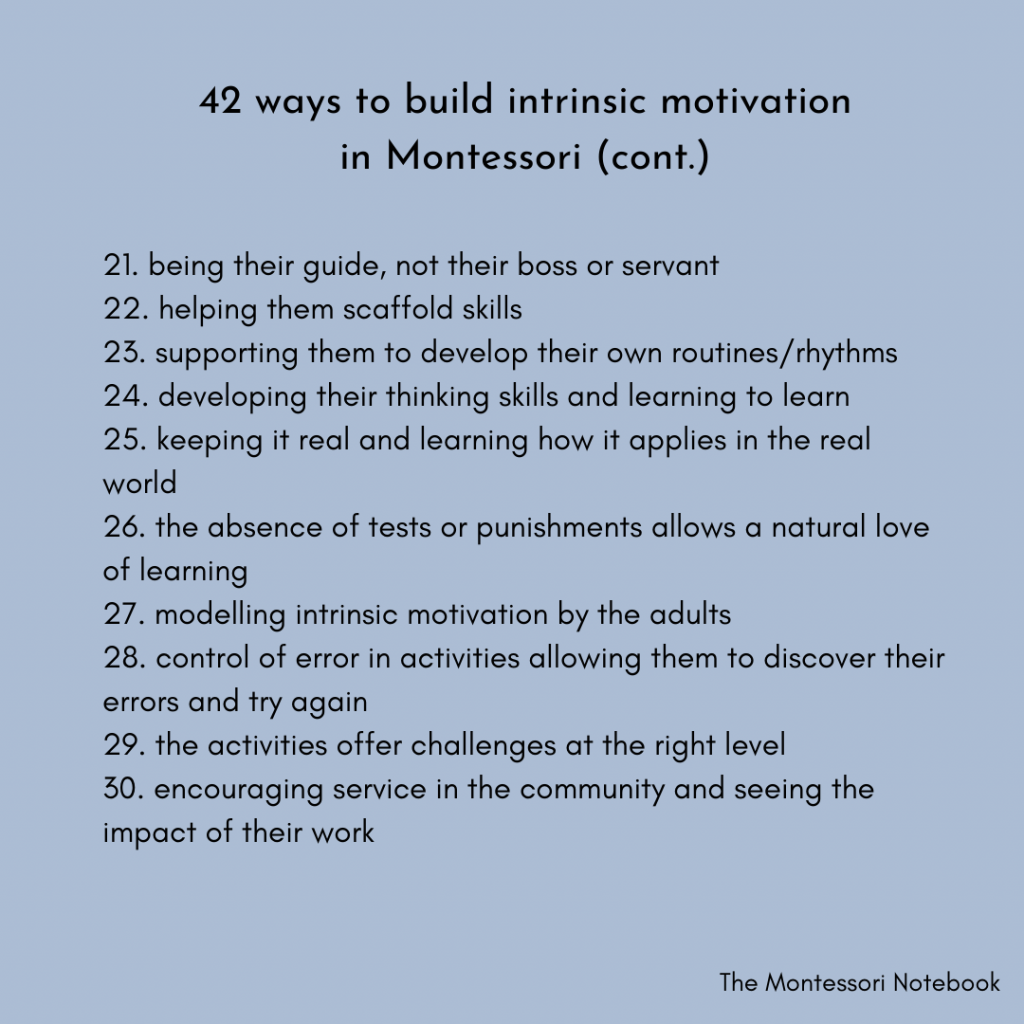Beyond rewards, bribes and punishment – a Montessori approach to building intrinsic motivation
In my last article on a Montessori approach to discipline, I mentioned that we don’t use rewards, bribes or punishment in a Montessori classroom. And there is not a teacher at the front telling everyone what they need to do. Yet if you observe in a Montessori classroom, there is a gentle hum of conversation and movement, and a lot of concentrated children who are motivated to work.
So, not surprisingly, I received many questions about a Montessori approach to building intrinsic motivation in the child. Intrinsic motivation is doing something because you have the inner drive to do it, not because of some external reason like a reward or threat.
I love a good list so here are 42 ways that the Montessori approach builds intrinsic discipline in our children.
Note: It’s a holistic approach where each part is intrinsically linked. So, whilst it may seem overwhelming to do all of these things, rest assured they also naturally build on one another.
42 ways to build intrinsic motivation
- build an environment where they can have success – from knowing where they can find things to having things at their level
- create opportunities for them to build independence – they see themselves as capable
- cultivate opportunities to work together, cooperate and care for others – they see their input matters; a 0-3 child is observing and beginning their social development in their family, with a carer, and/or nursery; the 3-6 child is part of their family and their class; and the 6-12 child wants to work and be a part of a group
- value process over product – there is more learning in the doing than in the final result
- use encouragement rather than praise – when they hear, “you worked hard to get your shirt on all by yourself” rather than “good job,” they learn to look to themselves what worked rather than looking to us for praise
- the freedom to work on things they are interested in – rather than what the teacher/adult tells them or a timeline
- safe limits – offer security and show someone cares about them
- the freedom to choose – what, where and with whom they’d like to work
- a clear rhythm to their day – they know what to expect
- learning respect for themselves, each other and the environment – they feel truly accepted and learn to accept others
- agreements made together – they feel like a valued member of the community
- it’s a safe place to practice boundaries – we can support them with words if needed, “I’d like to work by myself right now. It will be available soon.”
- honour who they are, each member a unique and valued part – builds their sense of self
- they learn to look after themselves, others and the environment – it’s empowering to be able to do this for yourself
- show trust in them – by removing external rewards and punishments
- help them to make amends when needed – they know that when they get it wrong, they will take responsibility and learn from the experience
- value curiosity – learning is about finding out rather than memorising facts
- allow them to have choices – they have agency in their days
- honest instructive feedback – we see what’s going well and how they can do better; gentle guidance how to keep improving
- provide different ways to learn – we all learn in different ways and on different days; the materials appeal to kinaesthetic, visual, and aural learners and they can choose how they’d like to present their work from a booklet to a survey to a poster etc.
- be their guide – not their boss or servant
- help them scaffold skills – each activity builds on the next to allow mastery
- support them to develop their own routines/rhythms like taking an activity to a table or mat and returning it when it’s done
- develop their thinking skills – they are learning to learn through hands on learning and making discoveries for themselves; they help younger children and consolidate their own learning; they reflect on what they have learned
- keep it real – they are not learning just for the sake of learning, but learning how it applies in the real world giving meaning to their work
- the absence of tests or punishments allows a natural love of learning – maintains their creativity and interest in learning
- model intrinsic motivation ourselves as adults – our actions are more powerful than our words
- control of error in activities – allows them to discover their errors and try again
- the activities offer challenges at the right level – they don’t feel unmotivated as they know that they can do hard things but they are not so hard they want to give up
- encourage service in the community – for example, volunteering and seeing the impact of their work
- there is a healthy relationship with failure – the guide and classmates are supportive; they are able to stay with something until they master it and are ready to move onto the next activity; and they learn to ask for help if needed
- remove competition for sticker charts or praise – helps them look to themselves not to someone else
- allow time to help them build skills – for example, planning skills, learning to dress themselves, how to make a report
- the child is in charge of their own learning – they learn uniquely, have their unique interests, and are on their unique timeline
- the adult trusts the process – without forcing our agenda
- support them to be a member of their society – how to be with others
- be patient – learning happens at its own pace and isn’t forced
- plant seeds of curiosity – enough to get them interested, and not too much to allow them to discover the rest for themselves
- the possibility for big work and big ideas – that looks at the interdisciplinary nature of the universe
- allow space for all voices – we want everyone in our community to feel valued, accepted and safe
- avoid criticism or correction – instead we observe where they are at and offer another opportunity to teach it again
- learn from others – we can see others learning and be inspired to learn that too
It’s never too late to start applying these principles. We can even scaffold the skills with a child in upper elementary (9-12 years), first helping them plan, then letting them take over more and more steps themselves.
And if you are wondering if this approach prepares children for the real world, see the further reading below.
Further reading
- how mastery is built into Montessori in this article “Montessori activities vs open-ended play“
- does Montessori prepare children for the real world?
To share on social media
Please tag and credit me @themontessorinotebook





Simone Davies has more than 20 years’ experience as an AMI Montessori educator. Simone is the author of “The Montessori Toddler” and co-author of “The Montessori Baby” and “The Montessori Child” books, comprehensive guides to raising children in a Montessori way. She currently runs parent-child Montessori classes in Amsterdam at her school Jacaranda Tree Montessori. She also has a popular blog, instagram and podcast “The Montessori Notebook” and is mother to two young adults.